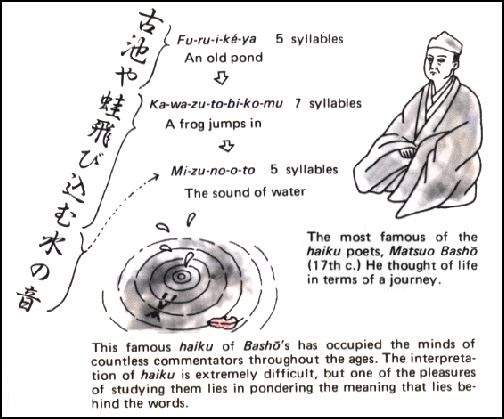Modern Japanese gendai (現代) haiku are increasingly unlikely to follow the tradition of 17 on or to take nature as their subject, but the use of juxtaposition continues to be honoured in both traditional haiku and gendai. There is a common, although relatively recent, perception that the images juxtaposed must be directly observed everyday objects or occurrences.
In Japanese, haiku are traditionally printed in a single vertical line while haiku in English often appear in three lines to parallel the three phrases of Japanese haiku.
Although the word "on" is often translated as "syllable", in fact one on is counted for a short syllable, an additional one for an elongated vowel, diphthong, or doubled consonant, and one more for an "n" at the end of a syllable. Thus, the word "haibun", though counted as two syllables in English, is counted as four on in Japanese (ha-i-bu-n); and the word "on" itself, which English-speakers would view as a single syllable, comprises two on: the short vowel o and the moraic nasal n̩. This is illustrated by the Issa haiku below, which contains 17 on but only 15 syllables. In addition, some sounds, such as "kyo" (きょ) can be perceived as two syllables in English but is a single on in Japanese.
Some translators of Japanese poetry have noted that about 12 syllables in English approximates the duration of 17 Japanese on.

Japanese poem about nature

Despite the brevity of haiku,

a haiku poem and have to

When the Japanese write their

forms of Japanese poetry.

Nature and Haiku Poetry

Each of his poems is printed

Haiku, Natural Japanese Poetry

A Japanese Haiku poem written

of the Japanese haiku poem

Most haiku poems are written

Modern haiku poems

Haiku Poems

How to Write a Haiku Poem?

haiku poems, japanese haiku,

Haiku poems are becoming more
In Japanese, haiku are traditionally printed in a single vertical line while haiku in English often appear in three lines to parallel the three phrases of Japanese haiku.
Although the word "on" is often translated as "syllable", in fact one on is counted for a short syllable, an additional one for an elongated vowel, diphthong, or doubled consonant, and one more for an "n" at the end of a syllable. Thus, the word "haibun", though counted as two syllables in English, is counted as four on in Japanese (ha-i-bu-n); and the word "on" itself, which English-speakers would view as a single syllable, comprises two on: the short vowel o and the moraic nasal n̩. This is illustrated by the Issa haiku below, which contains 17 on but only 15 syllables. In addition, some sounds, such as "kyo" (きょ) can be perceived as two syllables in English but is a single on in Japanese.
Some translators of Japanese poetry have noted that about 12 syllables in English approximates the duration of 17 Japanese on.

Japanese poem about nature

Despite the brevity of haiku,

a haiku poem and have to

When the Japanese write their

forms of Japanese poetry.

Nature and Haiku Poetry

Each of his poems is printed

Haiku, Natural Japanese Poetry

A Japanese Haiku poem written

of the Japanese haiku poem

Most haiku poems are written

Modern haiku poems

Haiku Poems

How to Write a Haiku Poem?

haiku poems, japanese haiku,

Haiku poems are becoming more



